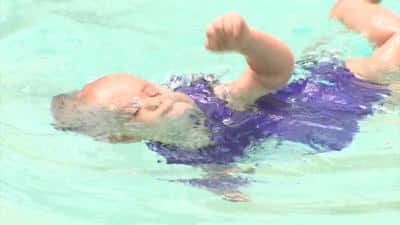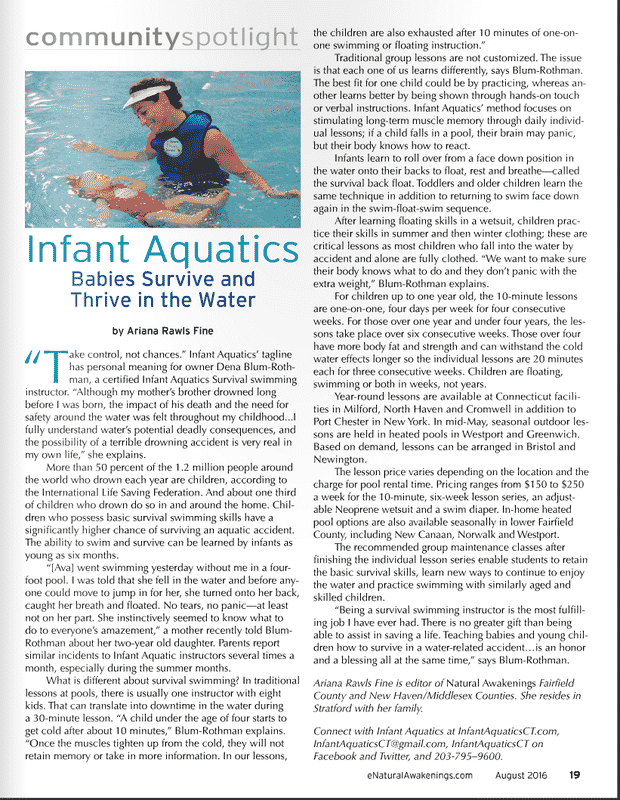In The News
In The News
News piece that aired on May 25, 2022 on Fox61
‘It can happen to anyone’ | Ansonia aquatics program teaches young children water safety
Drowning is the leading cause of death for children one to four years old. Infant Aquatics CT in Ansonia is looking to teach them water safety basics.
ANSONIA, Conn. — With summer just around the corner and as pools open for the season, it’s “We do not use any flotation devices whatsoever, we’re able to teach infants how to float and roll over on their backs alone and maintain it until they’re rescued if they fall into the pool alone,” said owner Dena Blum-Rothman.important to remember life-saving techniques that can protect children from water accidents.
Little swimmers are learning life-saving swimming techniques starting at just 6 months old at Infant Aquatics CT in Ansonia.
“They’re accidents, it’s not bad parenting it can happen to anyone,” said a parent who is taking part in the program.
“We do not use any flotation devices whatsoever, we’re able to teach infants how to float and roll over on their backs alone and maintain it until they’re rescued if they fall into the pool alone,” said owner Dena Blum-Rothman.
The programs are for 6-month-olds all the way to 6-year-olds. After just four weeks, with ten-minute lessons, those children learn to keep themselves above water.
“We’re teaching long-term muscle memory. It’s very similar to teaching a child how to walk, they do a couple of minutes every day,” said Blum-Rothman.
The program stimulates what real-life accidents could look like. The program has kids practice not only floating in bathing suits but regular clothes and winter clothes so regardless of what they’re wearing, they’re still able to get themselves up and on their backs
“A diaper for example can weigh seven pounds if it’s soaking wet. We make sure regardless of what they’re wearing, my babies can do the skills just as easily,” said Blum-Rothman.
Drowning is the number one cause of death in toddlers one to four years old according to the Centers for Disease Control and Prevention (CDC).
Parents said watching their little ones float is an added layer of protection for safety and peace of mind.
“She can float, she can go under, she can be dropped in the pool and comes right back up,” said Melissa Sok.
“Although you still have to watch them, they have the confidence when they go into water they won’t have a traumatic experience,” said one parent.
“He rolls over and he’s more calm and he can stay that way for a couple of minutes,” said another parent.
More information on the program can be found at Infant Aquatics CT’s website.
Lindsey Kane is a reporter at FOX61 News. She can be reached at Lkane@fox61.com. Follow her on Facebook, Twitter, and Instagram.
News piece that aired on July 20, 2020 on Fox61
Author: Maggie Slysz
Published: 9:15 AM EDT July 20, 2020
Updated: 9:15 AM EDT July 20, 2020
HARTFORD, Conn. — Summer means fun in the sun… and the water! In this week’s Family First we’re discussing water safety during the pandemic.
According to the CDC, drowning is the leading cause of unintentional death for children ages one to four.
Early swimming lessons can help protect children, but with everything that’s going on, you may have put those on hold. Or perhaps you’re wondering if they’re currently available and in a safe manner.
Dena Blum Rothman from Infant Aquatics CT has taught children and babies this important life skill for the past thirteen years. She says when it comes to learning how to swim: don’t delay. The sooner the safer, especially these days!
Dena’s program starts for babies as young as 4- 6 months, or as soon as baby can roll over on their own. She says an infant typically completes her program in 4 weeks. By this time they can float on their own in the water.
Like many organizations and businesses, the pandemic forced Dena to shut down for two months back in March. She eventually received permission from the COVID-19 response team for the State of Connecticut to teach out of her home. Equipped with underwater N95 masks, Dena was grateful to get her students back in the pool. She says with so many parents staying home these days, there’s been an influx of pools and kiddie pools in backyards and that she’s frightened just thinking about the threat that poses for children.
Dena has some tips for parents and caregivers to consider this summer to keep their kids safe in the water.
- If you have a kiddie pool, dump the water out as soon as you’re done using it and flip it over on its side. Don’t let rain water accumulate.
- If you have a pool and your child goes missing, perhaps playing a game of hide and go seek, check the pool FIRST.
- Don’t teach your kids to blow bubbles for fun. They don’t know the difference between a sippy cup, and bathtub or a pool. Instead, you want to teach them to be able to hold their breath.
- Don’t catch your child when they jump into a pool. This act teaches them that someone will be there to catch them whenever they want to jump in. Let them jump and go underwater and grab your hand to come up instead.
- Be aware of swimming programs that use flotation devices that keep you in a vertical position, which is the drowning position.
For more information on Dena’s Infant Aquatics program, please check out: https://infantaquaticsct.com/
News piece that aired on July 28, 2016 on CBS News nationwide
CBS NEWS July 28, 2016, 3:59 PM
Baby swimming class aims to keep infants safe in the pool
Steamy temperatures in the dog days of summer mean families across the country are heading to the pool or beach to cool off.
But fun in the sun can quickly turn tragic for small children when water is involved. In fact, when it comes to preventable injuries, drowning is the leading cause of death in children aged 1 to 4, according children’s advocacy group Safe Kids Worldwide. Babies under a year old are more likely to drown at home in the bathtub or even a bucket.
That’s why certified aquatics survival instructor, Dena Blum-Rothman, offers a class that teaches infants as young as 6 months old how to survive in the water.

“Accidents happen and we want to arm children with the ability to save themselves,” she told CBS News.
All it takes is 10 minutes a day, four days a week for a month for a child to learn water survival skills, Blum-Rothman said. Young children respond to positive reinforcement as they learn what to do.
“We’re really rewarding the tiniest approximation of something correct and they start realizing, ‘oh she liked when I did that!'” she said. “All of a sudden, in a few weeks you’ve got a swimmer, you’ve got a floater and they’re safe.”
Rick Terry enrolled his 9-month-old daughter, Erin, in Blum-Rothman’s class in Milford, Connecticut. Now, when she’s let go in the water, Erin knows what to do: she rolls over onto her back and kicks her legs, keeping her face above the surface.
“She’s a kicker and a mover,” her father said. “She loves it. She loves the water and she’s always jumping in and splashing. It’s a good time.”
Nine-month-old Erin Terry shows off her aquatics survival skills.
CBS NEWS
According to Safe Kids, nearly 800 children died from drowning in the U.S. in 2014. More than half of them were under the age of 5. The organization reports that two-thirds of fatal drownings each year occur between May and August.
Blum-Rothman says kids can drown in seconds, even with adult supervision.
“Things happen. You blink. You’re distracted,” she said. “You didn’t realize that the gate was open. It’s not bad parenting. It’s an accident.”
That’s why demand for such lessons keeps growing. And while some parents may have a hard time watching their kids go under, even in a controlled setting, one dad has some advice.
“If you’re nervous as a parent, get over it,” Phillip Ludwig said, “because these are your kids’ lives.”
© 2016 CBS Interactive Inc. All Rights Reserved.
Community Spotlight article from "Natural Awakenings" magazine, August 2016 Edition


News piece that aired June 29, 2016 on WTNH/News 8 - CT Style

MILFORD, Conn. (WTNH) — You may think it will never happen to you, but according to the U.S. Consumer Product Safety Commission, a child can drown in the time it takes to answer a phone. That’s why more and more parents are choosing to enroll their kids as young as seven months old in a special kind of swim class.
“They’re leaning in reaching for a toy, or they see a butterfly or reflections of the sun, and they’re drawn to it, so they just kind of lean thinking that they’re safe, and whoop, they fall right in,” said Dena Blum-Rothman, a certified infant aquatics survival instructor from Infant Aquatics CT.
She can’t even walk or talk yet, but thanks to Blum-Rothman, nine-month-old Erin Terry knows how to stay afloat if she ever falls into water.
“I want to make sure that after they fall in, that they’re able to bring themselves up to the surface, roll onto their back, and maintain that float until they’re rescued,” Blum-Rothman explained. “If they can walk, they’re then going to take that to the next stage, where they’re going to be able to turn over and swim to a wall, a ladder, a stair, some form of safety.”
Drowning is a leading cause of death among kids five years and younger, which is why Blum-Rothman says classes like these are critical.
“I get emails every single year, ‘I didn’t even know ‘Johnny’ can open the sliding glass door … Oh, we found the kids floating today. Thank you so much!’” Blum-Rothman recalled. “I had a little boy that had literally just finished his lessons, mom and dad were around the pool, he fell head first into the deep end. Mom and dad didn’t know how to swim. He came right up, floated, swam to the side, didn’t cry. He was perfectly calm, perfectly happy, because we had practiced it so many times before that it was just another day in the pool.
It doesn’t take long for an infant or child to learn these life-saving skills. Classes are just 10 minutes long. Infants meet four days a week for four consecutive weeks and kids from one to four years old meet for six weeks.
Erin’s father Rick Terry says the infant aquatics class has prepared his daughter for just about every possible situation.
“You put her under water down to almost to the bottom of the pool she’ll come right back up,” he explained. “They’ve put her in not just the wetsuit. They’ve done a snowsuit, shorts, jeans, shoes … From start to finish every time she’s been perfect.”
For parents, the classes are peace of mind.
“My husband and I, we see the statistics every year of just these horrible accidents of children drowning in pools and you know or any body of water; I did not want my son to be one of those statistics.” said Sarah McGovern-Luka, whose son is currently taking a class with Blum-Rothman.
“It’s a very good feeling and it’s comforting to know that you know for a couple of seconds they’ll be ok,” said Dennie Donaldson, whose son and daughters are enrolled in a class.
It’s comfort that every mom and dad can appreciate.
“I have people that say, ‘Oh I never take my eyes off my children,’” Blum-Rothman said. “We all do. It’s not bad parenting. It’s life. We blink. We turn our back for a second they’re gone like that, and it doesn’t take very long. It’s one inch between safety and not safety, and we just need to make sure that they can do it for themselves.”
For more information about Blum-Rothman’s swim classes, visit InfantAquaticsCT.com.
News piece that aired on August 20, 2015 on Eyewitness News 3 - WFSB Connecticut
MILFORD, CT (WFSB) -Drowning doesn’t just happen in the summer, but it can happen year-round, especially among children.
There is no way to guarantee that a child is never going to drown, but there is one technique that will give children an extra layer of protection while swimming.
Dena Blum-Rothman, of Infants Aquatic CT, has dedicated her life to teaching survival swimming lessons to those as young as 6 months old.
“It only takes 1 inch between life and death,” she said.
Her swimming lessons, she said, teach children how to survive if they accidentally fall in the water.
“They can bring themselves up to the surface, learn to float and maintain that float until they’re rescued, or swim to the side and get themselves out of the pool,” Blum-Rothman said.
Instructors are able to teach infants how to have control of their breath and roll over onto their backs and float from a face down position.
“It’s basically through a series of releases that we do; it’s all done through sensory motor skills–through touch,” Blum-Rothman said.
As the water starts to rise on their face, the baby has a physical response to block the water from going into the child’s mouth, through muscle memory.
“Either the traditional, closing of their lips; some kids stick their tongue out and plug it; and others just close their throat and they kind of spit it out like a fountain,” she said.
Lessons for floaters run for about one month, four days per week for just 10 minutes per day.
The lessons are taught at indoor pools across the state.
“We try really hard to reach as many families as possible,” she said.
Parents said they admitted they were a little reluctant at first.
“My husband was a little nervous but now we’re so glad that we did it,” said Lauren Ferris of Trumbull.
“We have a pool in the backyard, so we knew we had to protect our children and we wanted them to learn how to survive in case anything happened,” said Bennett Goss of Trumbull.
Once the baby can walk, they can move onto learning how to actually swim.
Copyright 2015 WFSB (Meredith Corporation). All rights reserved.


